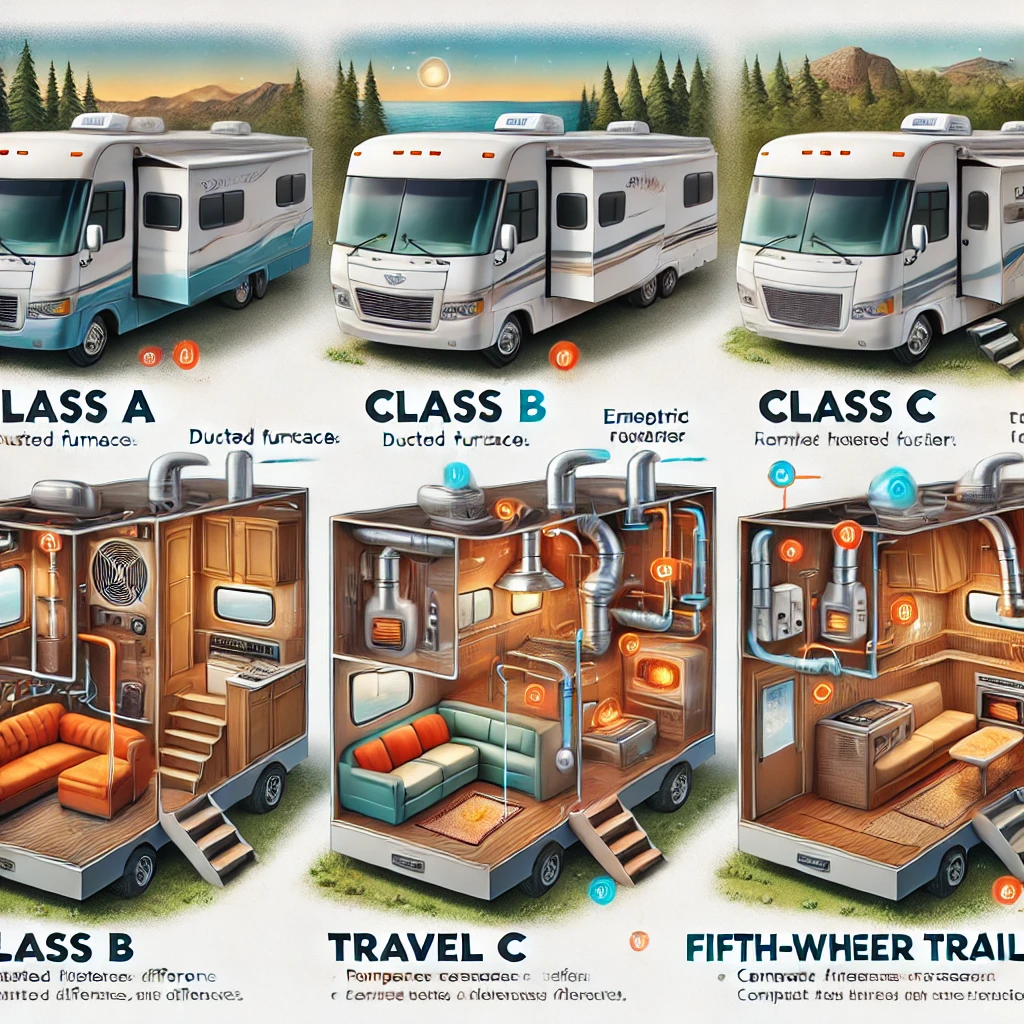When camping in your RV, staying warm is essential, especially during colder months. A common question many RVers ask is, “Does an RV furnace need electricity?” The answer is yes, but it’s not the full story. Let’s break it down for you.
How Does an RV Furnace Work?
RV furnaces use propane as their primary fuel source to generate heat. However, electricity plays a vital role in powering the furnace’s blower and control system. The blower circulates warm air throughout your RV, ensuring even heating. Without electricity, the furnace cannot distribute heat effectively.

What Kind of Electricity Does an RV Furnace Use?
RV furnaces typically rely on 12-volt DC electricity from your RV’s battery. This means you don’t need to be plugged into shore power to run your furnace. However, the furnace will draw power from your battery, so it’s crucial to ensure your battery is adequately charged.
Key Tip:
If you’re off-grid, consider using solar panels or a generator to keep your battery charged while running the furnace.
Can You Run an RV Furnace Without Electricity?
Unfortunately, you cannot run an RV furnace without electricity. While propane heats the air, the blower fan requires electricity to operate. If your battery dies or there’s a power issue, your furnace will stop working, leaving you in the cold.
How to Optimize Your RV Furnace Usage
- Monitor Battery Levels: Ensure your RV battery is fully charged before using your furnace.
- Use a Backup Power Source: Solar panels or portable generators are excellent options for keeping your battery charged.
- Insulate Your RV: Reduce heat loss by sealing windows and using RV skirting.
Does an RV Furnace Need Electricity?
If you’re an RV owner, you might wonder, “Does an RV furnace need electricity?” The short answer is yes, but there’s more to it. Here’s a step-by-step breakdown to help you understand how your RV furnace operates and why electricity is essential.
How an RV Furnace Produces Heat
The primary heating source for an RV furnace is propane gas. When the thermostat detects a drop in temperature, it signals the furnace to ignite the propane burner, creating heat.
Electricity Powers the Blower Fan
Once the furnace produces heat, electricity powers the blower fan to circulate warm air throughout your RV. Without electricity, the heat generated by propane will remain trapped, and your RV won’t stay warm.
Source of Electricity for the Furnace
An RV furnace uses 12-volt DC electricity from your RV’s battery. It doesn’t require direct shore power to function, but a fully charged battery is crucial for uninterrupted operation.
What Happens if There’s No Electricity?
Without electricity:
- The blower fan stops working.
- Heat cannot circulate.
- The furnace shuts off entirely to prevent overheating.
Tips to Keep Your Furnace Running Efficiently
- Check Battery Levels Regularly: Ensure your RV battery is fully charged before using the furnace.
- Use Backup Power Sources: A generator or solar panels can keep your battery charged.
- Improve Insulation: Add RV skirting or thermal curtains to minimize heat loss.

Different Classes of RV and Their Furnaces
When choosing an RV, it’s essential to understand the differences between the classes and how their furnaces operate. RVs come in various sizes and types, and each class has a unique heating system tailored to its layout and needs. Let’s explore the different classes of RVs and their furnaces to help you make an informed decision.
Class A RVs: Luxury Motorhomes with Powerful Furnaces
Class A RVs are the largest and most luxurious motorhomes, often equipped with residential-style amenities.
Furnace Features in Class A RVs:
- Ducted Heating Systems: Distribute heat evenly across multiple zones.
- Propane Furnaces: Typically paired with high-capacity units for heating large spaces.
- Supplemental Heating Options: Many Class A RVs include heat pumps or electric fireplaces.
Class B RVs: Compact Vans with Space-Saving Furnaces
Class B RVs, also known as camper vans, are compact and designed for easy travel.
Furnace Features in Class B RVs:
- Compact Propane Furnaces: Small, efficient units to fit limited spaces.
- Combination Systems: Some models use dual heating systems, like hydronic or catalytic heaters, to save space.
- 12-Volt Compatibility: Ensures the furnace operates efficiently off the battery for boondocking.
Class C RVs: Family-Friendly with Versatile Heating
Class C RVs offer a middle ground between Class A and Class B in terms of size and features.
Furnace Features in Class C RVs:
- Propane Forced-Air Furnaces: Provide consistent heating for medium-sized interiors.
- Ducted or Non-Ducted Options: Depending on the model, heat may be distributed through ducts or directly from the furnace.
- Battery-Powered Blowers: Ensure warm air circulation during off-grid stays.
Travel Trailers: Lightweight with Custom Heating Systems
Travel trailers come in various sizes, from teardrop trailers to large towable campers.
Furnace Features in Travel Trailers:
- Non-Ducted Furnaces: Common in smaller trailers to save space.
- Ducted Systems: Found in larger models for better heat distribution.
- Propane-Powered Units: Efficiently heat compact living areas.
Fifth-Wheel RVs: Spacious with Advanced Furnaces
Fifth-wheel trailers are known for their luxury and spacious layouts.
Furnace Features in Fifth-Wheel RVs:
- High-BTU Furnaces: Designed to heat large interiors effectively.
- Ducted Systems: Provide even heating across multiple levels.
- Dual Heating Systems: Often include electric fireplaces or radiant floor heating.
Pop-Up Campers: Minimalist Heating Options
Pop-up campers are lightweight and compact, offering basic amenities.
Furnace Features in Pop-Up Campers:
- Small Propane Furnaces: Efficiently heat small, enclosed spaces.
- Catalytic Heaters: A common alternative for low-energy heating.
- Battery-Dependent Systems: Ensure portability and ease of use off-grid.

Common Mistakes RV Owners Make with Furnaces and How to Fix Them
Owning an RV is a fantastic way to explore the open road, but maintaining your RV furnace is essential for comfort, especially in colder months. Unfortunately, many RV owners make common mistakes that can lead to furnace issues. Let’s look at these mistakes and provide practical solutions to keep your RV warm and cozy

Ignoring Regular Maintenance
Failing to clean and inspect your RV furnace can lead to decreased efficiency or complete failure. Dust, dirt, and debris often clog the furnace’s components, reducing airflow and causing the system to overwork.
Solution:
- Schedule Annual Inspections: Have a professional inspect your furnace annually.
- Clean the Components: Regularly clean vents, ducts, and the furnace area to prevent clogs.
- Check the Filters: Replace dirty filters for better airflow and efficiency.
Draining the Battery Too Quickly
An RV furnace relies on your battery to power the blower and control panel. Many RV owners underestimate how much electricity the furnace uses, leaving them with a dead battery.
Solution:
- Monitor Battery Levels: Use a battery monitor to keep track of usage.
- Invest in Backup Power: Consider solar panels or a portable generator to recharge your battery.
- Use Alternative Heating Sources: Use catalytic heaters or extra blankets to reduce furnace reliance.
Running the Furnace with Poor Propane Supply
Running the furnace with low or contaminated propane can cause inefficient heating or damage to the system.
Solution:
- Check Propane Levels Regularly: Refill or replace your propane tanks before they run empty.
- Inspect Propane Lines: Ensure there are no leaks or blockages in the propane system.
- Use Clean Propane: Choose high-quality propane to avoid impurities damaging the furnace.
Blocking Air Vents
Covering or obstructing the furnace vents can restrict airflow, causing uneven heating and potential overheating.
Solution:
- Keep Vents Clear: Ensure vents and ducts are free from obstructions like furniture or clutter.
- Distribute Heat Evenly: Use vent covers that redirect airflow to areas that need more heat.
- Inspect Vents for Debris: Clean out any dust or blockages regularly.
Using the Furnace in Extreme Weather Without Preparation
Using the furnace in freezing conditions without proper preparation can cause it to work harder, leading to malfunctions or breakdowns.
Solution:
- Winterize Your RV: Seal windows and doors, use RV skirting, and insulate pipes to retain heat.
- Preheat the RV: Run the furnace for short intervals before temperatures drop significantly.
- Check for Frozen Propane Lines: In freezing conditions, ensure propane lines are insulated or thawed.
Not Testing the Furnace Before a Trip
Many RV owners fail to test their furnace until they’re already on the road, leading to unpleasant surprises.
Solution:
- Test Before Traveling: Run your furnace for a few minutes before your trip to ensure it works properly.
- Perform a Functionality Check: Inspect the thermostat, blower, and propane system during the test.
- Carry Spare Parts: Keep extra filters, fuses, and a toolkit for minor repairs.
Conclusion
Avoiding these common mistakes can save you from unexpected furnace issues and ensure your RV stays warm during your travels. Regular maintenance, monitoring your power and propane supplies, and testing your furnace are key to a trouble-free RV experience. By following these simple solutions, you can enjoy a cozy, comfortable journey no matter the weather.
More related details will be available on Flamingo Motorhomes.

